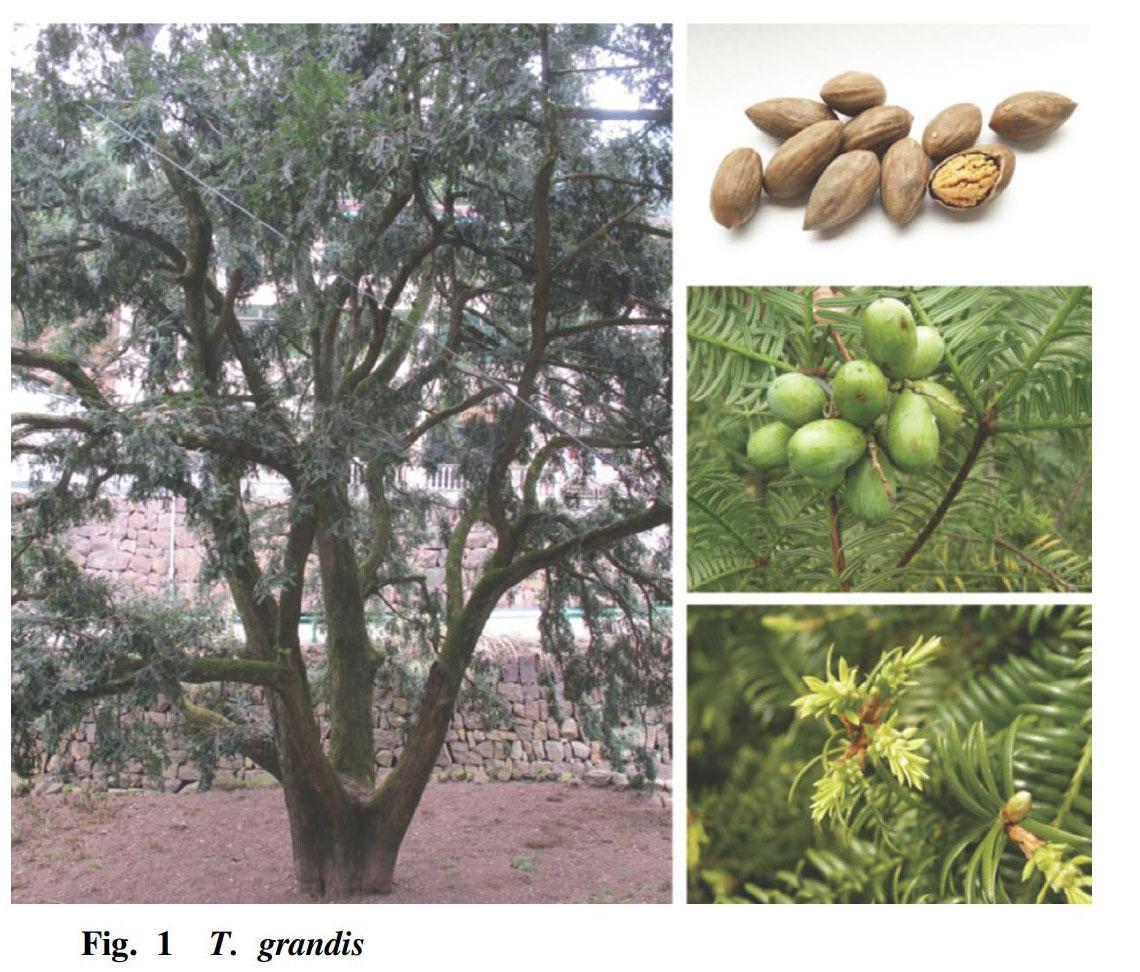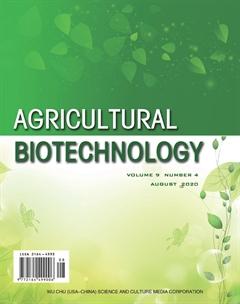Nutrients Determination in Nuts from Different Torreya grandis Cultivars
Yongqing CAO Huadong REN Xiaohua YAO Kailiang WANG



Abstract [Objectives] This study aimed to investigate the differences in nutritional properties of nuts from different Torreya grandis cultivars.
[Methods] Seven T. grandis cultivars were selected to analyze the protein, soluble carbohydrate, vitamin E, amino acids and fatty acid composition, and evaluate nutritional value of T. grandis nuts from different cultivars using gray correlation analysis.
[Results] The kernels of T. grandis contained 9.47%-13.3% protein, 1.92%-2.36% soluble carbohydrate, 0.16-0.22 mg/g vitamin E, 8.40%-11.55% amino acids, and 42.09%-49.29% fatty acid including 35.14%-40.14% oleic acid. And the coefficient of variation ranged from 5.02% to 18.9% among different cultivars. Meanwhile, the average contents of essential amino acids (E), nonessential amino acids (N) and children essential amino acids (C) were 3.88%, 6.07% and 0.99%, respectively. The ratios of E/T and E/N were quite stable and in fully compliance with the recommendation standards of amino acids composition from WHO/FAO.
[Conclusions] Overall, the nutritional value of tested seven cultivars could be ranked in the following decreasing order using gray correlation analysis: T. grandis cv. Dong No.2>T. grandis cv. Longfeng>T. grandis cv. Dingshan>T. grandis cv. Merrilli>T. grandis cv. Dong No.3>T. grandis cv. Dong No.1>T. grandis cv. Zhuyan.
Key words Torreya grandis; Nutrients; Cultivar; Gray correlation degree
Torreya grandis (T. grandis), an evergreen coniferous tree belonging to Torreya of Cephalotaxaceae (Fig. 1), is mainly distributed in Southeast China [1-3]. As a native Chinese tree species, its nut seeds have been used as food for over two thousand years in China and become one of the worlds rare dry fruit with distinctive texture, charming flavor and physiological function because of their high nutritional value and medicinal properties[4-5]. The consumption of T. grandis nuts is increasingly popular in Eastern China. To meet the market demand, over ten cultivars with different properties were selected in recent years besides the traditional cultivar T. grandis cv. Merrilli. The most famous of them are T. grandis cv. Longfeng, T. grandis cv. Dingshan, T. grandis cv. Zhuyan, T. grandis cv. Dong No.1, T. grandis cv. Dong No.2 and T. grandis cv. Dong No.3.
Previous studies have demonstrated that T. grandis seeds are rich in nutritive content and bioactive components[5-8]. And the content of the chemical components, like protein, kernel oils, tocopherols, varied among populations from different geographical origins[2,9]. To the best of our knowledge, few research has compared the differences in nutritional properties of nuts from different cultivars above.
In the present study, we evaluated the variation in protein, soluble carbohydrate, vitamin E, fatty acid and amino acid composition in kernels of seven T. grandis cultivars and appraised their nutritional value as a whole. The results will help to develop further support for consumption and production of T. grandis in the future.
Material and Methods
Sample collection
The fully matured seeds of T. grandis cv. Merrilli, T. grandis cv. Longfeng, T. grandis cv. Dingshan, T. grandis cv. Zhuyan, T. grandis cv. Dong No.1, T. grandis cv. Dong No.2 and T. grandis cv. Dong No.3 were collected from eight years old trees planted in Dongyang germplasm resources nursery, Zhejiang Province. And at least 0.5 kg of seed samples was collected for each cultivar. The unshelled kernels were dried in open air for 1 week (moisture content close to 10%) and then stored at room temperature in sealed polyethylene bags for further analysis.
Protein, soluble carbohydrate, vitamin E, fatty acid and amino acid determination
The protein content was determined by Kjeldahl method using FOSS Kjeltec 8400. And quantification of soluble carbohydrate was performed by anthrone colorimetry. Vitamin E was assayed according to the official methods by Reversed Phase High Performance Liquid Chromatography (Waters 2695, USA)[10] .
The oils were obtained via the petroleum ether extraction using soxhlet extractor (Buchi B-811, Switzerland). Fatty acid composition was analyzed by hydrolytic extraction gas chromatography (Agilent 7890B, USA)[11,12] .
The amino acid composition was analyzed by Hitachi L-8800 amino acid analyser[13]. Essential amino acids (E) content was calculated with sum of Ile, Leu, Lys, Thr, Val, Phe and Met. Nonessential amino acids (N) was calculated with sum of His, Arg, Cys, Ala, Asp, Glu, Gly, Pro, Ser and Tyr. Children essential amino acids (C) were calculated with sum of His and Arg.
Results and Discussion
Nutrients determination in kernels of different T. grandis cultivars
The results in Table 1 represent the content of protein, soluble carbohydrate, vitamin E and fatty acid composition varied in different T. grandis cultivars. The protein content ranged from 9.47% in kernel of T. grandis cv. Merrilli to 13.3% in T. grandis cv. Dong No.2 and the average content was 11.47%. The average content of soluble carbohydrate was 2.36% with the lowest 1.92% in T. grandis cv. Dong No.2 and the highest 3.29% in T. grandis cv. Longfeng. The content of vitamin E ranged from 0.16 mg/g in kernel of T. grandis cv. Merrilli, T. grandis cv. Zhuyan and T. grandis cv. Dong No.1 to 0.22 mg/g in kernel of T. grandis cv. Dingshan. The average content of vitamin E was 0.17 mg/g. The fatty acid composition also varied obviously among different cultivars. The average content of fatty acid and oleic acid was 45.70% and 35.80%, respectively. And the fatty acid content in kernel ranged from 42.09% to 49.29% and the oils comprised 35.14%-40.14% oleic acid in different cultivars. While no obvious correlation was shown between fatty acid and oleic acid content. E.g. the fatty acid content in kernel of T. grandis cv. Merrilli was the highest, while the oleic acid only account for a middle level of 37.57% in fatty acid.
In addition, the coefficient of variation for each nutrient was different. And the highest variation was found in soluble carbohydrate content and the coefficient of variation reached 18.9%, while only 5.02% in fatty acid.
Amino acid composition analysis in kernels of different T. grandis cultivars
As shown in Table 2, we detected 17 different amino acids in kernels of T. grandis and seven kinds of essential amino acids included. The content of total amino acids varied among different cultivars and the average content of total amino acids (T) was 9.95%, ranging from 8.40% to 11.55%. Meanwhile, the average contents of essential amino acids (E), nonessential amino acids (N) and children essential amino acids (C) were 3.88%, 6.07% and 0.99%, respectively. The ratios of E/T (0.39) and E/N (0.64) were quite stable with the coefficient of variation less than 0.01%. And it was in fully compliance with the recommendation standards of amino acids composition from WHO/FAO[14] (FAO/WHO 1973). The nutritional value of T. grandis was higher than that of Macadamia in terms of amino acids composition[15].
General comparison of nutritional value
Seven indexes were selected to evaluate nutritional value of T. grandis nuts from different cultivars using gray correlation analysis (Table 3). The gray correlation degree of T. grandis cv. Dong No.2 and T. grandis cv. Longfeng was the highest and reached 0.731 0 and 0.723 0, respectively. It was shown that their nutritional value was also higher. The gray correlation degree of T. grandis cv. Dingshan was 0.651 5 and its general nutritional value was in the middle level. And the nuts from T. grandis cv. Merrilli, T. grandis cv. Dong No.3, T. grandis cv. Dong No.1 and T. grandis cv. Zhuyan had the lowest nutritional value. According to the gray correlation degree, the nutritional value of the tested seven cultivars could be ranked in the following decreasing order: T. grandis cv. Dong No.2>T. grandis cv. Longfeng>T. grandis cv. Dingshan> T. grandis cv. Merrilli>T. grandis cv. Dong No.3>T. grandis cv. Dong No.1>T. grandis cv. Zhuyan.
Conclusions
The protein, soluble carbohydrate, vitamin E, amino acids and fatty acid varied obviously among different cultivars and their average contents were 11.47%, 2.36%, 0.17 mg/g, 9.95% and 45.70%, respectively. Besides, the ratios of E/T (0.39) and E/N (0.64) were in fully compliance with the recommendation standards of amino acids composition from WHO/FAO and T. grandis should be a healthy food peculiar to eastern China. And the cultivar T. grandis cv. Dong No.2 showed the highest nutritional value in this research.
References
[1] BEATRICE G, FRANCESCO G, VIRGINIA L, et al. Grandione, a new heptacyclic dimer diterpene from Torreya grandis Fort[J]. Tetrahedron, 1999(55): 11385–11394.
[2] HE Z, ZHU H, LI W, et al. Chemical components of cold pressed kernel oils from different Torreya grandis cultivars[J]. Food Chemistry, 2016(209): 196-202.
[3] SHI LK, MAO JH, ZHENG L, et al. Chemical characterization and free radical scavenging capacity of oils obtained from Torreya grandis Fort. ex. Lindl. and Torreya grandis Fort. var. Merrillii: A comparative study using chemometrics[J]. Industral Crops and Products, 2018(115): 250-260.
[4] LI ZQ, DAI WS. Torreya grandis in China[M]. Beijing: Science Press, 2007. (in Chinese)
[5] NI Q, GAO Q, YU W, et al. Supercritical carbon dioxide extraction of oils from two Torreya grandis varieties seeds and their physicochemical and antioxidant properties[J]. LWT-Food Science and Technology, 2015, 60(2): 1226-1234.
[6] CHEN BQ, CUI XY, ZHAO X, et al. Antioxidative and acute anti-inflammatory effects of Torreya grandis[J]. Fitoterapia, 2006(27): 262-267.
[7] DONG D, WANG H, XU F, et al. Supercritical carbon dioxide extraction, fatty acid composition, oxidative stability, and antioxidant effect of Torreya grandis seed oil[J]. Journal of the American Oil Chemists Society, 2014(91): 817-825.
[8] NI L, SHI WY. Composition and free radical scavenging activity of kernel oil from Torreya grandis, Caya cathayensis and Myrica rubra[J]. Iranian Journal of Pharmaceutical Research, 2014(13): 221-226.
[9] AYERZA R and COATES W. Protein content, oil content and fatty acid profiles as potential criteria to determine the origin of commercially grown chia (Salvia hispanica L.)[J]. Industrial Crops and Products, 2011, 34(2): 1366-1371.
[10] National Health and Family Planning Commission of China. GB/T 5009.82-2016. Determination of vitamin A, vitamin D and vitamin E in foods[S]. Beijing: China Standard Press. (in Chinese)
[11] National Food Industry Standardizaiton Technical Committee. GB/T 22223-2008. Determination of total fat, saturated fat, and unsaturated fat in foods—Hydrolytic extraction—Gas chromatography[S]. Beijing: China Standard Press (in Chinese)
[12] RUI Y, WANG W, ZHANG F, et al. A new kind of fatty acid emerging from transgenic cotton seed. Riv Ital Sostanze Gr, 2007(84): 40-43.
[13] Ministry of Health, PRC. GB/T5009.124-2003. Determination of amino acids in foods[S]. Beijing: China Standard Press.(in Chinese)
[14] DU LQ, ZENG H, ZOU MH, et al. Differences analysis of amino acid contents in macadamia kernel[J]. Non wood Forest Research, 2008, 26(4): 49-52. (in Chinese)
[15] FAO/WHO. FAO nutrition meeting report series: Energy and protein requirements[R]. Roma: WHO, 1973.
- 农业生物技术(英文版)的其它文章
- Investigation on Agronomic Characters of Dwarf Mutant 778 in Broomcorn Millet (Panicum miliaceum L.) and Analysis of Its Sensitivity to GA
- Construction of Technology System on Development and Repropagation in Vitro of Several Cultivars in Pear
- Construction of Camellia oleifera Cultivation Standardization System
- Photosynthetic Physiological Response to Drought Stress of Populus euphratica at Different Ages in Minqin
- Effects of UV-B Radiation on the Activity of Antioxidants in Flue-cured Tobacco Leaves
- Analysis of Differences in Biochemical Components Between Yunnan and Kenya Tea Tree Varieties

